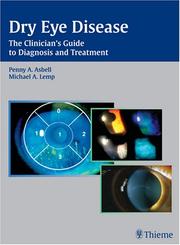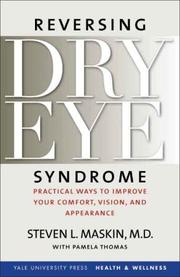| Listing 1 - 8 of 8 |
Sort by
|

ISBN: 1588904121 3131397713 9781588904126 9781588904126 9783131397713 9783131397713 Year: 2006 Publisher: New York : Thieme,
Abstract | Keywords | Export | Availability | Bookmark
 Loading...
Loading...Choose an application
- Reference Manager
- EndNote
- RefWorks (Direct export to RefWorks)

ISBN: 3540533087 Year: 1992 Publisher: Berlin : Springer,
Abstract | Keywords | Export | Availability | Bookmark
 Loading...
Loading...Choose an application
- Reference Manager
- EndNote
- RefWorks (Direct export to RefWorks)
Book
ISBN: 0323827535 0323827543 9780323827546 9780323827539 Year: 2022 Publisher: Elsevier,
Abstract | Keywords | Export | Availability | Bookmark
 Loading...
Loading...Choose an application
- Reference Manager
- EndNote
- RefWorks (Direct export to RefWorks)
Clinically-oriented and up-to-date, Dry Eye Diseases focuses on the latest diagnostic techniques, management guidelines, and treatment options for dry eye disorders. This consolidated resource provides guidance on the clinical assessment of patients presenting with dry eye symptoms as well as a global perspectives on the use of FDA and off-label products. Practicing and trainee ophthalmologists and optometrists will find this an indispensable resource for understanding this complex disorder.
Dry eye syndromes. --- Dry Eye Syndromes --- diagnosis. --- Dry eye disorders --- Lacrimal apparatus --- Syndromes --- Diseases --- diagnosis --- therapy --- Dry Eye --- Dry Eye Disease --- Evaporative Dry Eye --- Evaporative Dry Eye Disease --- Evaporative Dry Eye Syndrome --- Dry Eye Diseases --- Dry Eye Syndrome --- Dry Eye, Evaporative --- Dry Eyes --- Evaporative Dry Eyes --- Dry eye syndromes

ISBN: 075064978X 9780702038310 0702038318 9780750649780 Year: 2003 Publisher: [Place of publication not identified] Butterworth Heinemann
Abstract | Keywords | Export | Availability | Bookmark
 Loading...
Loading...Choose an application
- Reference Manager
- EndNote
- RefWorks (Direct export to RefWorks)
Lacrimal Apparatus Diseases --- Eye Diseases --- Diseases --- Dry Eye Syndromes --- Dry Eye --- Dry Eye Disease --- Evaporative Dry Eye --- Evaporative Dry Eye Disease --- Evaporative Dry Eye Syndrome --- Dry Eye Diseases --- Dry Eye Syndrome --- Dry Eye, Evaporative --- Dry Eyes --- Evaporative Dry Eyes --- Eye Disorders --- Eye Disease --- Eye Disorder --- Ophthalmology --- Epiphora --- Apparatus Disease, Lacrimal --- Apparatus Diseases, Lacrimal --- Disease, Lacrimal Apparatus --- Diseases, Lacrimal Apparatus --- Lacrimal Apparatus Disease

ISBN: 1281735027 9786611735029 0300135254 9780300135251 9781281735027 9780300111767 0300111762 9780300122855 0300122853 Year: 2007 Publisher: New Haven Yale University Press
Abstract | Keywords | Export | Availability | Bookmark
 Loading...
Loading...Choose an application
- Reference Manager
- EndNote
- RefWorks (Direct export to RefWorks)
This clear, accessible book combines detailed medical information with expert treatment advice for the estimated twenty million Americans who suffer from dry eye syndrome. Dr. Steven L. Maskin, an ophthalmologist who has been caring for dry eye patients for more than fifteen years, explains exactly what the syndrome is, why it occurs, and how it can best be managed and treated. He dispels the misunderstandings that surround dry eye syndrome and presents an easy-to-understand guide that may be read cover-to-cover or dipped into for specific topics of interest. Dr. Maskin begins with an overview of dry eye syndrome, then explains the myriad ways it can develop (allergies, aging, contact-lens use, LASIK surgery, diabetes, and various other diseases). He discusses how it can be successfully diagnosed and treated, offers guidelines for choosing a doctor and appropriate medications, and describes useful home remedies. In a concise final chapter, the doctor provides welcome answers to frequently asked questions. For patients who want to understand their disease and to participate actively in its management, this book is an essential reference.
Dry eye syndromes --- Eye --- Eyeball --- Eyes --- Visual system --- Face --- Photoreceptors --- Vision --- Dry eye disorders --- Lacrimal apparatus --- Syndromes --- Diseases --- Dry Eye Syndromes

ISBN: 9780702038310 0702038318 9780750649780 075064978X Year: 2003 Publisher: [Place of publication not identified] Butterworth Heinemann
Abstract | Keywords | Export | Availability | Bookmark
 Loading...
Loading...Choose an application
- Reference Manager
- EndNote
- RefWorks (Direct export to RefWorks)
Lacrimal Apparatus Diseases --- Eye Diseases --- Diseases --- Dry Eye Syndromes --- Disease.

ISBN: 0750641967 9780702038174 0702038172 9780750641968 Year: 2002 Publisher: Oxford Boston Butterworth-Heinemann
Abstract | Keywords | Export | Availability | Bookmark
 Loading...
Loading...Choose an application
- Reference Manager
- EndNote
- RefWorks (Direct export to RefWorks)
Bodily Secretions --- Lenses --- Lacrimal Apparatus Diseases --- Eye Diseases --- Optical Devices --- Fluids and Secretions --- Anatomy --- Diseases --- Equipment and Supplies --- Analytical, Diagnostic and Therapeutic Techniques and Equipment --- Dry Eye Syndromes --- Tears --- Contact Lenses --- Contact Lens --- Lenses, Contact --- Lens, Contact --- Meibomian Lipids --- Meibum --- Lipid, Meibomian --- Meibomian Lipid --- Tear --- Lacrimal Apparatus --- Dry Eye --- Dry Eye Disease --- Evaporative Dry Eye --- Evaporative Dry Eye Disease --- Evaporative Dry Eye Syndrome --- Dry Eye Diseases --- Dry Eye Syndrome --- Dry Eye, Evaporative --- Dry Eyes --- Evaporative Dry Eyes --- Device, Medical --- Devices, Medical --- Equipment --- Inventories --- Medical Device --- Supplies --- Apparatus and Instruments --- Devices --- Medical Devices --- Device --- Instruments and Apparatus --- Inventory --- Supplies and Equipment --- Anatomies --- Secretions and Fluids --- Optical Components --- Optical System --- Component, Optical --- Components, Optical --- Device, Optical --- Devices, Optical --- Optical Component --- Optical Device --- Optical Systems --- System, Optical --- Systems, Optical --- Optics and Photonics --- Eye Disorders --- Eye Disease --- Eye Disorder --- Ophthalmology --- Epiphora --- Apparatus Disease, Lacrimal --- Apparatus Diseases, Lacrimal --- Disease, Lacrimal Apparatus --- Diseases, Lacrimal Apparatus --- Lacrimal Apparatus Disease --- Secretions --- Bodily Secretion --- Secretion --- Secretion, Bodily --- Secretions, Bodily
Book
ISBN: 303921991X 3039219901 Year: 2020 Publisher: MDPI - Multidisciplinary Digital Publishing Institute
Abstract | Keywords | Export | Availability | Bookmark
 Loading...
Loading...Choose an application
- Reference Manager
- EndNote
- RefWorks (Direct export to RefWorks)
Blindness and visual impairment impact significantly on an individual’s physical and mental well-being. Loss of vision is a global health problem, with approximately 250 million of the world’s population currently living with vision loss, of which 36 million are classified as blind. Visual impairment is more frequent in the elderly, with cataract and age-related macular degeneration (AMD) accounting for over 50% of cases globally. Oxidative stress has been strongly implicated in the pathogenesis of both conditions, and consequently the role of nutritional factors, in particular carotenoids and micronutrient antioxidants, have been investigated as possible preventative or therapeutic strategies. Dry eye syndrome (DES) is one of the most common ophthalmic conditions in the world. DES occurs where the eye does not produce enough tears and/or the tears evaporate too quicklyleading to discomfort and varying degrees of visual disturbance. There has recently been a great deal of interest in the potential for oral or topical supplementation with essential fatty acids (EFAs), specifically omega-3 and omega-6 fatty acids, as an adjunct to conventional treatments for DES. The objective of this Special Issue on ‘Nutrition and Eye Health’ is to publish papers describing the role of nutrition in maintaining eye health and the use of nutritional interventions to prevent or treat ocular disease. A particular (but not exclusive) emphasis will be on papers (reviews and/or clinical or experimental studies) relating to cataract, AMD and DES.
polyphenols --- n/a --- crocin --- chyrsin --- glaucoma --- dietary assessment --- photoreceptor degeneration --- dry eye --- RR-zeaxanthin --- nutritional supplements --- drug discovery --- corneal neovascularization (CNV) --- AMD --- dietary antioxidants --- micronutrients --- age-related macular degeneration --- preclinical models --- lenses --- microvascular lesions --- cyclooxigenase-2 (COX-2) --- angiogenesis --- fish oil --- macrophage --- anti-oxidant --- vascular endothelial growth factor (VEGF) --- rosmarinic acid --- visual cycle --- diabetic retinopathy --- lutein --- gut-retina axis --- light damage --- crocetin --- supplements --- clinical practice guidelines --- nutrition --- light --- eye disease --- dietary habits --- flavonoids --- phytoconstituents --- saffron --- carotenoids --- fatty acid --- electroretinography --- lens --- advanced glycation end products --- interleukin-1? (IL-1?) --- mesozeaxanthin (RS zeaxanthin) --- endoplasmic reticulum stress --- omega-3 polyunsaturated fatty acids --- clinical survey --- corneal chemical burn --- reduced glutathione --- omega-3 --- AGREE II --- retina --- inflammation --- anti-inflammatory --- retinal pigment epithelium --- diet --- Lactobacillus paracasei KW3110 --- Crocus Sativus L. --- saponins --- cataract --- CODS --- neoangiogenesis --- estrogen-deficient rats --- food frequency questionnaire --- gut microbiota --- antioxidant supplements --- sinapic acid --- personalised medicine --- systematic reviews --- nuclear factor-kappaB (NF-?B) --- diabetes --- Cucurbita argyrosperma --- oxidative stress --- endoplasmic reticulum
| Listing 1 - 8 of 8 |
Sort by
|

 Search
Search Feedback
Feedback About UniCat
About UniCat  Help
Help News
News